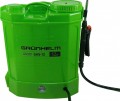Productivity (liquid)
Maximum performance of the sprayer when working with liquid; Please note that in pump (see "Type of pumping") and battery (see "Type") models, the actual performance may decrease as the air supply or battery charge is exhausted.
High performance allows you to quickly process large areas; moreover, it is often combined with a good spraying distance (see below). On the other hand, such models require fairly large tanks — or they often have to be refilled; neither one nor the other contributes to the convenience of work. In addition, over-capacity is even more undesirable than under-capacity: a low-capacity sprayer will just take longer to process, and a too-capacity sprayer can ruin the job by “overdosing” the chemical. Therefore, it makes sense to use high-performance devices only for specific tasks.
Detailed data on optimal performance values for different situations can be found in special sources.
Max. pressure
The maximum operating pressure of the sprayer.
High pressure allows to achieve good spraying performance and range, however, actual performance can vary with units with the same pressure. Therefore, in general, the indicator is for reference (the lion's share of models has a
pressure of 3 bar and
4 bar, and it is only possible to compare different models by it approximately. When choosing, it makes sense to focus on more practical characteristics — performance, range, etc.
Max. fluid temperature
The maximum fluid temperature that the sprayer can safely handle.
The preparation process of some formulations requires heating; therefore, data on the temperature to which the liquid must cool can be very important for safe operation. However, even in the most heat-resistant sprayers, this figure does not exceed 40 °C; such a liquid feels warm to the touch.
It is worth remembering the temperature limits when the unit is in the sun: if the tank has had time to get very hot in the sun, you should let it cool down before starting work.
Spray wand length
The length of the spray tube supplied with the sprayer.
A long tube, on the one hand, allows you to reach far without leaving your seat and without using stools, ladders, etc.; on the other hand, it is not very manoeuvrable and can be inconvenient when working in tight spaces. When choosing, it is worth proceeding from the optimal compromise between these characteristics. For example, a large tube length (up to 2 m in some models) is useful when processing fruit trees, but for a greenhouse it is better to choose a shorter sprayer. It is also worth considering that some sprayers use telescopic (sliding) tubes, the length of which can be adjusted as needed; in such cases, the unfolded size of the atomizer is usually indicated.
Telescopic wand
Availability of a folding
telescopic tube in a set of delivery of a sprayer.
The length of such a tube can be adjusted within certain limits, adjusting it to the specifics of the situation. For example, in cramped conditions, a large length is not needed, but when processing tall trees, on the contrary, it is very convenient. Specific adjustment options may be different: in some models, you can choose only one of the two extreme positions (fully folded or fully unfolded), while others allow you to fix the handset in intermediate positions.
Capacity
Capacity of the complete battery in the battery sprayer (see "Type").
A higher capacity allows you to work longer without recharging, but this is true only “ceteris paribus” — the actual energy consumption (and therefore battery life) depends on the performance, range and some other characteristics of the sprayer. Therefore, only devices with similar indicators can be compared by this parameter, and it is easier to evaluate battery life by directly claimed operating time (see below). Also, larger batteries tend to weigh more and cost more. Therefore, manufacturers usually choose the battery capacity according to the features of a particular model — in order, on the one hand, to ensure good battery life, and on the other hand, not to greatly increase the weight and price.
Operating time
Time of continuous operation of the battery sprayer (see "Type") on one battery charge. The actual operating time may differ slightly from the claimed one due to the specifics of a particular situation, however, these differences are usually not very large, and this indicator can be used to evaluate not only theoretical, but also practical indicators of battery life.
Wand holder
The presence
of a tube clamp in the design of the sprayer.
Such a latch is a set of special clips, usually installed directly on the tank. It greatly simplifies the storage and transportation of the device: the handset, usually, is placed as compactly as possible and at the same time securely. Yes, and during breaks in work, this feature can come in handy — fixing the tube in the retainer is more convenient and safer than putting it on the ground, holding it in your hands, etc.
Weight
The total weight of the sprayer. Specified without taking into account the liquid or powder in the working tank; at the same time, for battery models (see “Type”), usually, the weight is given with a complete battery, and for gasoline models, on the contrary, “dry” weight, without fuel in the tank.

